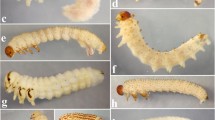Abstract
Tanypodinae usually form an important component in subfossil Chironomidae assemblages but can be difficult to identify beyond subfamily level due to fragmentation of subfossil material. However, generic identification of most subfossil specimens can be achieved by reference to the arrangement of cephalic setae. This paper presents the first identification guide to Holarctic Tanypodinae genera based on the cephalic setae. A total of 33 genera is described and illustrated, of which 9 were previously undescribed, and 26 descriptions are based on new material. A total of 42 species is illustrated to show intrageneric and intraspecific variation. Improved taxonomic resolution will enhance the performance of chironomid-environmental variable inference models and chironomid biostratigraphy.
Similar content being viewed by others
References
Bilyj, B., 1988. A taxonomic review of Guttipelopia (Diptera: Chironomidae). Entomologica Scand. 19: 1–26.
Birks, H. J. B., 1998. Numerical tools in palaeolimnology-Progress, potentialities, and problems. J. Paleolim. 20: 307–332.
Brodersen, K. P. & C. Lindegaard, 1999. Chironomid assemblages from Danish lakes. Classification, assessment and reconstruction of lake trophic state using a chironomid based chlorophyll a transfer function. In Brodersen, K. P. (ed.), Macroinvertebrate Communities in Danish Lakes: Classification and Trophic Reconstruction. Freshwater Biol. 42: 143–157.
Brooks, S. J. (submitted). Late-glacial fossil midge stratigraphies (Insecta: Diptera: Chironomidae) from the Swiss Alps. Palaeogeogr. Palaeoclimat. Palaeoecol.
Brooks, S. J. & H. J. B. Birks, 2000. Chironomid-inferred late-glacial and early-Holocene mean July air temperatures for Krå kenes Lake, western Norway. J. Paleolim. (in press).
Brooks, S. J., H. Bennion & H. J. B. Birks (submitted). Chironomidand diatom-total phosphorus inference models and their application to a sediment core from Betton Pool, Shropshire, UK. Freshwater Biol.
Clerk, S., R. Hall, R. Quinlan & J. P. Smol, 2000. Quantitative inferences of past hypolimnetic anoxia and nutrient levels from a Canadian Precambrian Shield lake. J. Paleolim. 23 (in press).
Cranston, P. S., 1996. Identification guide to the Chironomidae of New South Wales. Australian Water Technologies Pty. Ltd., 375 pp.
Fittkau, E. J. & S. S. Roback, 1983. The larvae of the Tanypodinae-Keys and diagnoses. In: Wiederholm, T. (ed.), Chironomidae of the Holarctic region. Keys and Diagnoses. Part 1, Larvae, pp. 33–110. Entomologica Scand. Suppl. 19: 1–457.
Kowalyk, H. E., 1985. The larval cephalic setae in the Tanypodinae (Diptera: Chironomidae) and their importance in generic determinations. Can. Ent. 117: 67–106
Laville, H., 1971. Recherches sur les chironomides (Diptera) lacustres du Massif de Né ouvielle (Hautes-Pyré né es). Annals Limnol. 7: 173–332.
Little, J., 1999. Development and application of a chironomid-based model for inferring past hypolimnetic oxygen conditions in northeastern Ontario lakes. MSc Thesis, Dept. Biology, Queen's University, Kingston, Ontario.
Lotter, A. F., H. J. B. Birks, W. Hofmann & A. Marchetto, 1998. Modern diatom, Cladocera, chironomids and chrysophyte cyst assemblages as quantitative indicators for the reconstruction of past environmental conditions in the Alps. I. Climate. J. Paleolim. 18: 395–420.
Olander, H., A. Korhola, H. J. B. Birks & T. Blom, 1999. An expanded calibration model for inferring lake-water temperatures from chironomid assemblages in northern Fennoscandia. The Holocene 9: 279–294.
Quinlan, R., J. P. Smol & R. I. Hall, 1998. Quantitative inferences of past hypolimnetic anoxia in south-central Ontario lakes using fossil midges (Diptera: Chironomidae). Can. J. Fish. Aquat. Sci. 55: 587–596.
Saether, O. A., 1980. Glossary of chironomid morphology terminology (Diptera: Chironomidae). Entomologica Scand. Suppl. 14: 51 pp.
Stur, E. & E. J. Fittkau, 1997. Diagnostic characters distinguishing the larvae of Ablabesmyia and Paramerina, and the first record of Paramerina in Brazil. Spixiana 20: 161–165.
Walker, I. R., 1995. Chironomids as indicators of past environmental change. In: Armitage, P., P., S. Cranston & L. C. V. Pinder (eds), 1995. The Chironomidae: The Biology and Ecology of Non-Biting Midges. Chapman & Hall, London, pp. 405–422.
Walker, I. R., A. J. Levesque, L. C. Cwynar & A. F. Lotter, 1997. An expanded surface-water palaeotemperature inference model for use with fossil midges from eastern Can. J. Paleolim. 18: 165–178.
Walker, I. R., S. E. Wilson & J. P. Smol, 1995. Chironomidae (Diptera): quantitative palaeosalinity indicators for lakes of western Canada. Can. J. Fish. Aquat. Sci. 52: 950–960.
Wiederholm, T. (ed.), 1983. Chironomidae of the Holarctic region. Keys and diagnoses. Part 1. Larvae. Entomologica Scand. Suppl. 19: 1–457.
Zavrel, J., 1936. Tanypodinen-Larven und-Puppen aus Partenkirchen. Arch. Hydrobiol. 30: 318–326.
Author information
Authors and Affiliations
Corresponding author
Rights and permissions
About this article
Cite this article
Rieradevall, M., Brooks, S.J. An identification guide to subfossil Tanypodinae larvae (Insecta: Diptera: Chrironomidae) based on cephalic setation. Journal of Paleolimnology 25, 81–99 (2001). https://doi.org/10.1023/A:1008185517959
Issue Date:
DOI: https://doi.org/10.1023/A:1008185517959




